A lot of people are using conventional tents for their fishing trips. But there is a type of tent which is far more advanced than the average camping tent; the fishing bivvy.
A fishing bivvy is an advanced type of tent, which is commonly used for overnight carp fishing sessions. It is 100% waterproof and very easy to erect. Thanks to its heavy-duty fabric and thermal insulation, the bivvy is an all-season type of shelter that can withstand very cold temperatures, strong winds and heavy rainfall.
I have used bivvies for over ten years now and can honestly say that it is a vital element of my fishing equipment that I do not want to be without.
If you want to learn everything there is to know about fishing bivvies and why they are such a perfect fit for anglers, keep reading this article.
Most Important Features of a Fishing Bivvy
Everything about a fishing bivvy screams optimization and practicality.
This comes as no surprise, as bivvies were originally used in the army, by soldiers who had to camp out in the open and had to be able to quickly blend in with the natural environment that surrounded them.
This both explains that bivvies usually are green or camouflaged, very lightweight and that they are very easily erected and dismounted. All of these features fit fishermen more than well, which is why bivvies are such a popular choice for many anglers.
Easy to Erect And Dismount
The bivvy’s most exclusive feature is, without a doubt, the quick erect feature. There are bivvies that you can unwrap and fully mount in less than 60 seconds.
Most other, more basic models take only slightly longer to erect and can be fully mounted in anything between 2 and 5 minutes.
Equally, modern fishing bivvies can be dismounted and packed up in no time at all. For the angler who values time and optimization on the bank, the bivvy is the perfect shelter to use while fishing.
Lightweight
Carp and specimen anglers in particular are known to be drawn to bivvies and in venues in which carp or specimen fish can be found, bivvies are usually a common part of the local scenery.
These types of anglers carry a lot of gear with them to the bank, which means that any part of their equipment that isn’t adding much to the overall weight and volume of what they have to bring with them in their cars and down to the bank is highly appreciated.
Bivvies are clearly part of this category, as they can both weigh very little and take only a limited room when they are rolled up.
Many bivvies weigh under 15 lb, which is extraordinary if you consider that this weight equals a fully equipped and highly advanced outdoor shelter that will keep you warm and dry in almost any type of weather.
Compact
Both when erect and rolled up, bivvies are very compact and take up surprisingly little space.
A standard 1-bivvy measures an average height of 140cm, a length of 220cm, and a width of 275cm, which is a rather compact and limited space.
However, thanks to the bivvy’s roomy interior, you can virtually fit all of your gear, a camping mat, a bedchair or carp bed, your sleeping bag, and yourself into that bivvy.
And once you are done fishing and roll up your bivvy to pack it into its bag, it will measure no more than roughly 100cm in length, with a diameter of about 30cm!
And so, when rolled and packed up, a bivvy will fit into your car without taking much room at all!
Tent/Shelter Function
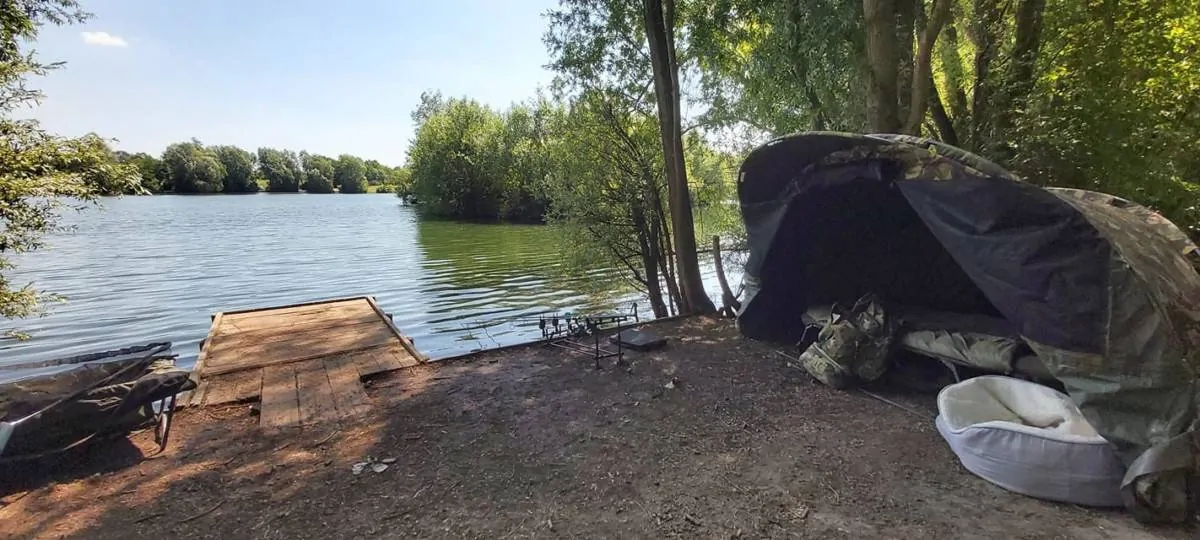
This is a very smart and practical feature that anglers find extremely useful. Many bivvies have removable fronts, which, if taken off, turn them into open shelters.
This basically means that your bivvy is a 2 -in-1 tent solution that can be used in bad weather and cold conditions (closed bivvy) and in good weather and warm conditions (open shelter).
Many anglers also prefer using the open shelter alternative, as it enables them to get to their rods faster at night.
The “cut-off” front of the open shelter allows for a rod pod, or bank sticks, to be placed directly in front of it, making it super easy for a sleeping angler to basically just reach out and pick up the rod after a take.
High Top
This is another great feature of the fishing bivvy; its raised roof. Standard bivvies can have heights of 140-160cm, giving anglers a lot of space to sit comfortably and upright on a chair inside the bivvy.
With the bivvy’s high top and extra headroom, there is no need for anglers to crouch down when entering or leaving their bivvy, which can be extra important when having to get to your rods rather quickly.
Large Windows And Door
Even with the bivvy fully closed, you can still enjoy a full view over your swim from within it, thanks to large PVC plastic windows, which are commonly detachable, and a large door, which can be rolled up all the way.
As a bonus, most of these openings are also covered with mosquito mesh, allowing you to detach the windows and roll up your front door without getting in any unwanted insects.
At night, when you don’t need to oversee your rods and swim, you simply cover all the openings again and enjoy a good night of sleep in a perfectly darkened bivvy, until you get a bite, that is!
Built In Groundsheet
Many fishing bivvies have built-in groundsheets that are attached to the bivvy. This feature has several advantages and adds to the overall comfort of the bivvy.
For one thing, you skip having any types of creepy crawlers in your tent at night, which is something any angler that ever woke up with a spider crawling over his face will appreciate.
For another thing, a built-in groundsheet prevents any cool air from streaming in through openings at the bottom of the tent.
This is especially comfortable when fishing cold spring or autumn nights when that cold air creeps in and disturbs your sleep, as your face is usually at the same height as the incoming air.
I have woken up from a cold, running nose because of that many times throughout the years until I got a bivvy with an attached groundsheet.
This 100% closed system also aids the bivvy’s overall isolation.
A final advantage of having a built-in groundsheet in your bivvy is that it makes your bivvy even more compact.
You simply erect, and then roll up your bivvy together with the groundsheet in one go, no separate folding of the groundsheet and no extra space taken by it either.
Twin-Skinned
More recent bivvy models come with a double outer layer of heavy-duty nylon fabrics, which aids both the bivvy’s isolation and insulation systems, as well as keeps condensation to an absolute minimum.
This design makes it possible for the bivvy to be warm and dry in cold weather, and cool and well air-conditioned in warm weather.
The heavy-duty fabrics that are commonly used for the bivvy’s outer layers also ensure many years of service; no scratches, no holes, and no reparations needed.
These high-quality materials also make sure that a bivvy is 100% waterproof. No matter how much heavy rain is pounding that bivvy, no water will ever get in, if those layers stay intact, it is truly marvelous!
Advanced Air Conditioning
Additionally to the bivvy’s front openings, there are usually a series of rear vents that ensure steady air conditioning and provide an essential flow of air. The latter is extra crucial for those hot summer nights on the bank.
For colder nights, the vents can easily be closed, in order to prevent the cooler air from coming in.
Different Types of Fishing Bivvies
Brollies
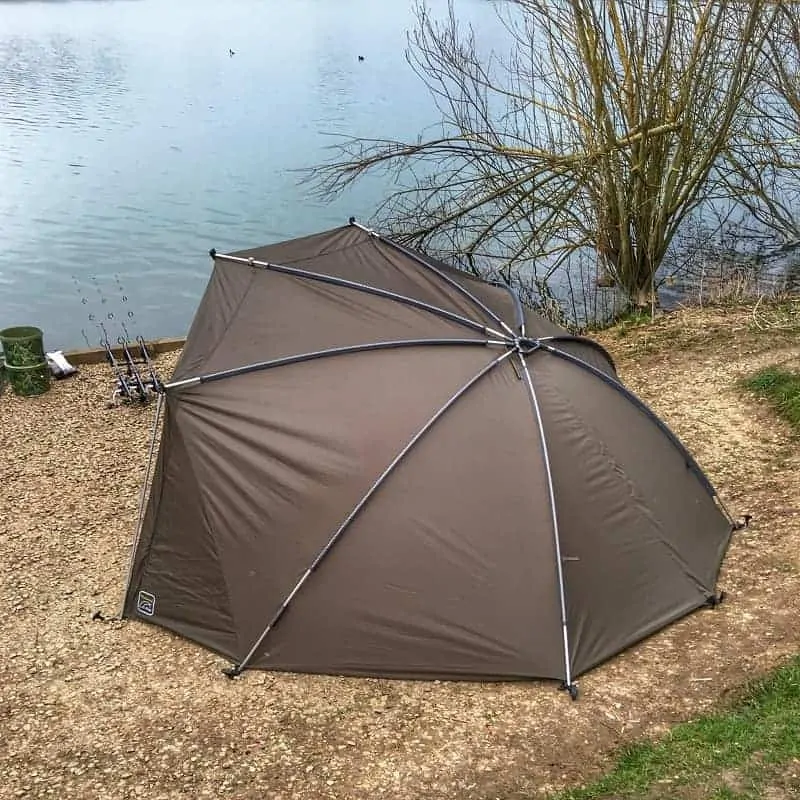
Brollies are open-front bivvies that are basically advanced umbrella shelters. They are very easily erected, light weighted and do not take much room when packed up.
Two adjustable quick sticks that can be attached to the brolly’s front give it better protection against wind and rain, as well as better overall stability.
Brollies are usually a 1-man size and are perfect for a short, spontaneous overnight session, as well as day sessions in bad weather.
2 and 3 Rib Bivvies
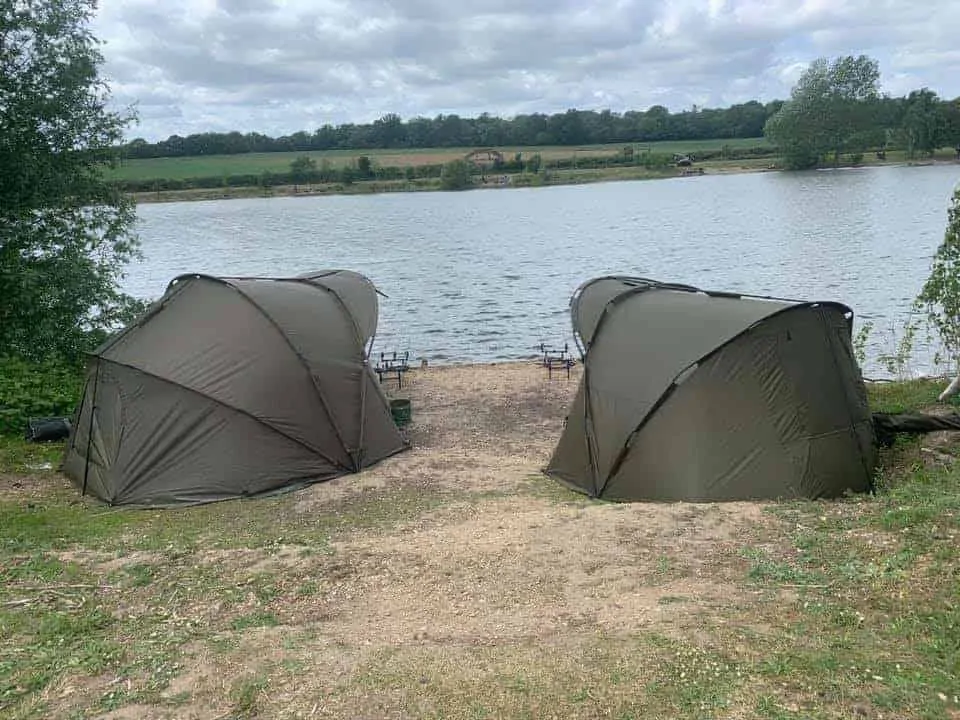
These are the most common types of bivvies. 2 rib models are often 1-man size bivvies, while 3 rib models are 2-man size versions of bivvies.
They have all the standard features and designs which are commonly associated with fishing bivvies; such as a quick and smooth pram hood style erection, heavy-duty fabric that can handle all types of weather, plenty of room for the angler and all of his gear, as well as a heavy-duty groundsheet, windows, a door and an overwrap.
2 and 3 rib bivvies are perfectly suitable for both overnighters and longer fishing trips that last several days.
Quick Erect Bivvies
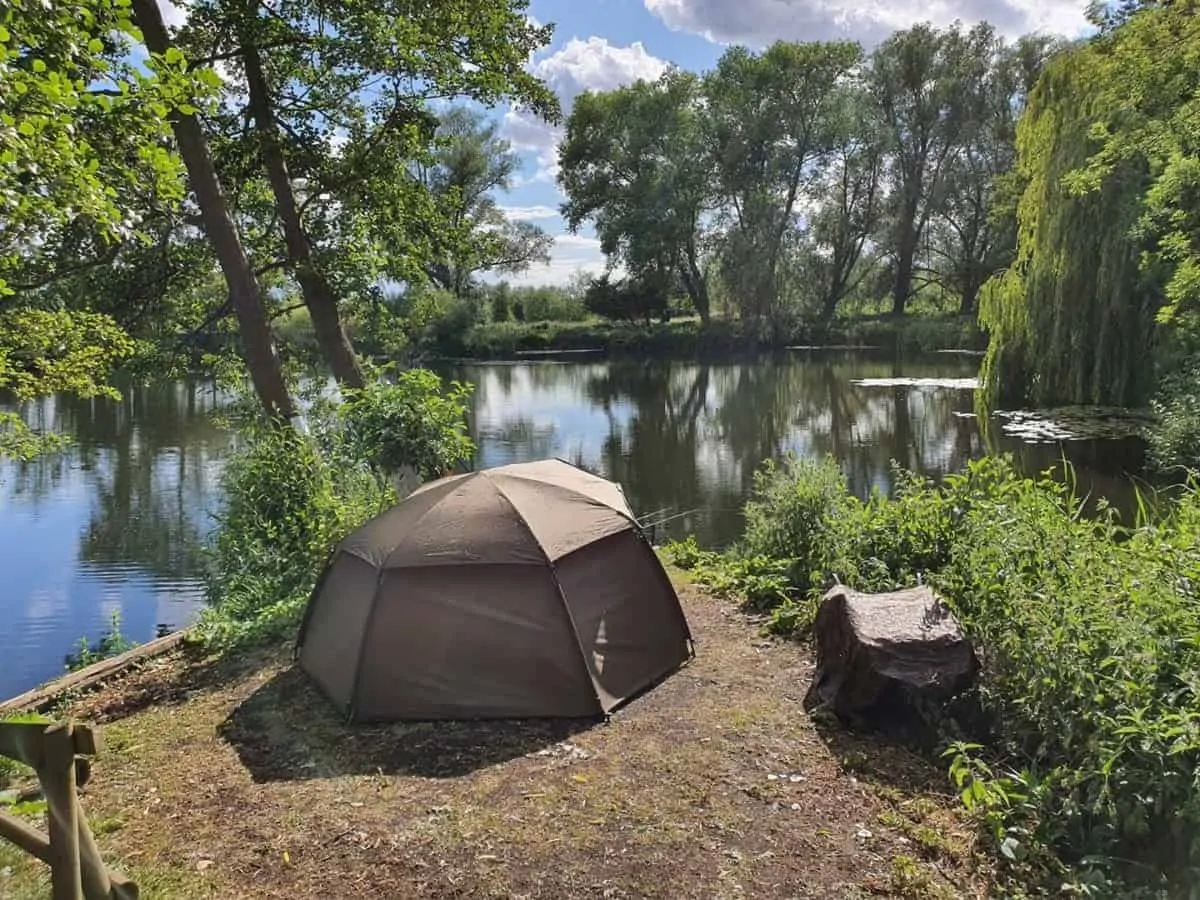
These are newer, even more advanced types of bivvies that combine the design of both brolly and conventional bivvy.
A quick erect bivvy is a bivvy with an umbrella or spider top section that can be unfolded and mounted extremely fast, making the quick erect bivvy the next-gen fishing shelter.
Some of these bivvies can be fully erected in less than 10 seconds while maintaining all the stability and robustness of a common bivvy.
This combination of features makes the quick erect bivvy a good choice for both short and long sessions, and for the angler who really values his time and wants to get fishing as quickly as possible after arriving on the bank.
Why Is It Called a Bivvy?
The term bivvy was first used by soldiers of the British Empire in the late 19th and early 20th centuries.
It derives from the original word “bivouac”, a French term, which, in turn, derived from the 18th-century Swiss-German word “Beiwacht” (by watch, or by patrol).
“Beiwacht” referred to an additional watch or patrol, maintained by a fellow soldier or a civilian for increased vigilance at a military encampment.
I suppose that, as bivvies became more and more popular within various outdoor sports in the UK from the 1960s and onward, angling simply adapted the trend and introduced bivvies as a new type of fishing tent, with a vast level of success, as it turned out.
What Is The Difference Between Tents And Bivvies?
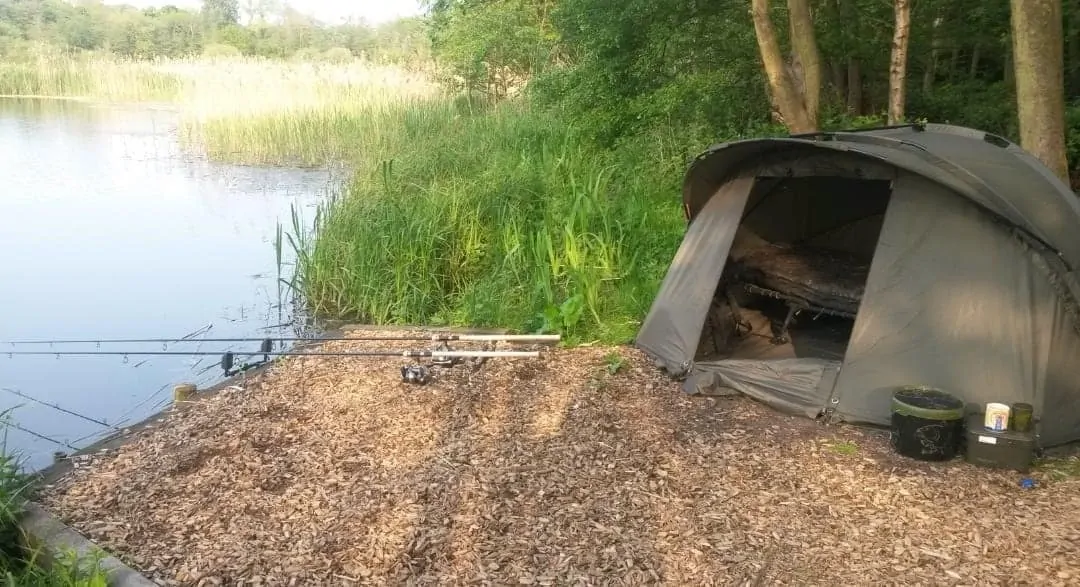
There are a few very essential differences between these two types of outdoor shelters and bivvies are by far the more advanced and comfortable shelters. They outrank camping tents both in terms of material, practicality and design.
Space & Design
The most essential difference between a conventional camping tent and a bivvy is that a tent is designed primarily for sleeping in, while a bivvy is designed for fishing.
Of course, you can use normal tents on your fishing trips as well, but bivvies are simply much more practical and comfortable when fishing.
While tents are generally lower, bivvies have a high top and a roomy head area, allowing anglers to comfortably sit, and sometimes even stand in them.
This is especially practical for fishing in bad weather if you have to spend a considerable amount of time in your tent.
Bivvies are also built with extra space for a lot of your gear in mind, whilst tents are primarily sleeping areas, allowing space for a mattress or a camping mat, as well as your sleeping bag.
In a bivvy, on the other hand, there is often room for both your sleeping area, a chair, your fishing bags, a cooler box, your shoes and extra clothing, etc.
So, while a tent is a mere sleeping space, a bivvy can be seen more as a miniature cabin, or perhaps even a living room.
Time to Mount
As explained earlier, bivvies can be erected in under 2 minutes, sometimes even less than 1 minute. This makes them both extremely practical and appreciated by the angler who likes to optimizes his time for fishing.
Tents, on the other hand, are generally not built with time optimization in mind. Their mounting time can be up to 10-15 minutes and often includes putting together many different parts.
On the contrary, bivvies are often a one-piece structure, meaning that they can be erected and dismounted in only a few steps and that there are no unnecessary extra parts to consider.
This also makes it much more convenient to move a bivvy around, as it’s rather common for anglers to try out different locations and fishing spots in a venue during their session.
Material
Tents are often built with thinner fabric, making them more vulnerable to both weather conditions and holes. These types of material will also significantly decrease a tent’s insulation and isolation capabilities.
A bivvy is made of material that is meant to last and withstand all types of weather and temperatures. It also manages to effectively decrease condensation, which is another thing tents are usually not that great at doing.
Camouflage
It is hard to find a bivvy that will not blend into the natural environment surrounding it. Often, bivvies are camouflaged in colors such as green, brown or grey.
Tents, on the other hand, can be extremely colorful and often stick out in a natural setting. And hence, they become a less desired choice for the fisherman who wants to stay hidden on the bank.
Weight & Size
In my opinion, this is the only category where a tent could be considered a superior choice. Regardless if you are on a very basic night fishing trip, hiking, or simply on a short camping overnighter, you will probably only have very light gear with you.
In such cases, bringing a small tent that can fulfill your basic sleeping needs would probably be the better move.
While being extremely practical and smartly designed, bivvies are heavier and somewhat bulkier than small, conventional camping tents. Rolled up, they will be around 3 feet in length and weigh anything between 10 to 20lb.
Very basic tents, on the contrary, can weigh as little as 2 to 4lb and can fit inside of a backpack, or can be attached to one.
As such, they can sometimes be a better choice, if you really only need a roof over your head and do not prefer sleeping out in the open while on a night fishing session with only little and light gear.
Alternatively, you could go for a brolly, which is a good middle way between a large and heavier bivvy and a super basic and simple tent.
By the way, if you want to read up on how to fish at night (with or without a bivvy), make sure you also read this article I wrote: How to Fish at Night The Right Way
What Are Some of The Best Fishing Bivvies?
When it comes to brollies, the Sonik AXS Brolly is an evergreen choice that has made overnighters of thousands of anglers comfortable and dry.
It has enough room for a big bed or mattress and pretty much all of your fishing tackle, which is rather luxurious when it comes to brollies.
It provides extremely good protection against rain and wind, is completely waterproof, and with 4.9kg, it has a very agreeable weight, for being such a compact and robust brolly.
As it can be erected in under a minute, it’s the perfect choice for a short overnight session!
Check all the specs and price of the Sonik AXS Brolly on Amazon here
A bivvy I can warmly recommend is the Fox EOS 2 Man Bivvy, which I have used myself for many years. It’s a modern classic that never gets old, and FOX, as a brand, always stands for top gear and great functionality.
It’s an awesome choice for both newcomers and seasoned anglers, and it’s really reasonably priced as well!
This 2-rig pram-hood bivvy will be raised in under 3 minutes, which is great, considering how compact and solid this shelter is.
I have even managed to erect it in just 2 minutes in complete darkness, equipped only with my head torch. If you can manage to quickly raise your bivvy at night without going mad, you know it has a good design and structure to it!
It also comes with a lightweight groundsheet, heavy-duty pegs for stormy weather, and a door with an integrated mesh insert, to keep those mossies away during summer.
It measures 275cm x 300cm x 150cm and only weighs 19 lb. I especially liked how roomy this bivvy is and how much you can actually fit in it!
You can take a closer look at the Fox EOS 2 Man Bivvy on Amazon here
What Is a Bivvy Overwrap?
An overwrap is basically an external second skin for your bivvy that you can put on when fishing in colder conditions or during winter.
Many standard bivvy models come with a separate overwrap, or “winter skin”. Only the newer, more modern versions are already equipped with a twin-skin, but in a few years, this design will probably become the new standard.
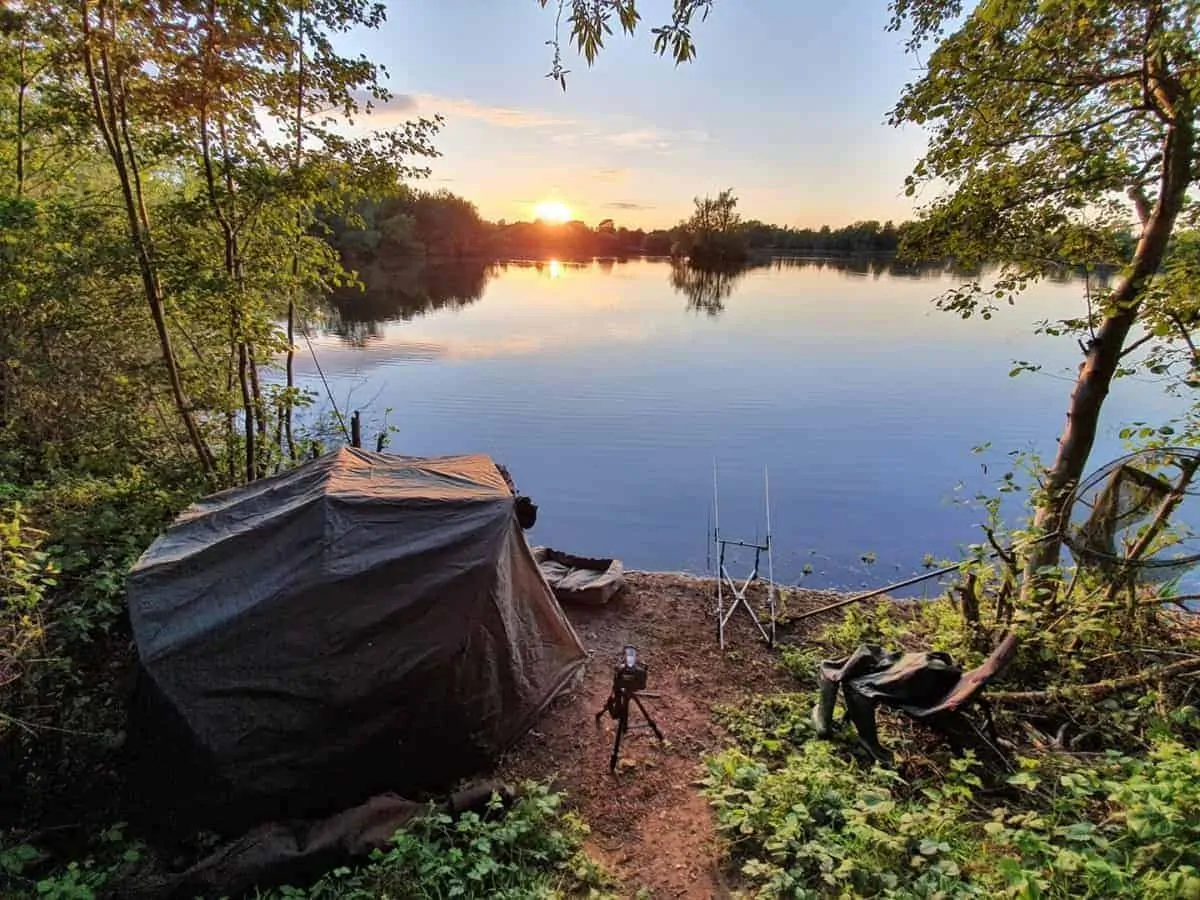
When used, an overwrap effectively traps the air between itself and the bivvy’s outer layer, which, in turn, warms up and aids the bivvy’s insulation. As a result, the bivvy’s inside will become warmer.
If you want to read up on camping gear for fishing trips and get some of my best tips for relevant equipment, head over to this section:
How Big Is The Biggest Fishing Bivvy?
During my online research, I found two bivvies that deserve the title “world’s biggest fishing bivvy”.
By far, Spyder’s Euro XL Continental Fishing Bivvy is the largest bivvy on the market. It measures a massive 350cm in width, 460cm in depth and 200cm in height.
This Goliath can comfortably shelter 4 adults with their respective mattress or bedchair and sleeping bag.
It’s the perfect fishing bivvy for a weekend out on the bank with your fishing buddies. Or why not bring your entire family with you for an overnight carp adventure in style and comfort? If your wife is up for it, that is!
Second place goes to the Nash Base Camp, which is a large bivvy with room for 2 to 4 persons.
As Nash always produces highly innovative products, they have actually come up with a very smart gazebo solution. The gazebo part acts as the central base for this bivvy.
To each side of that gazebo, a module sleeping pod can be connected, turning the bivvy into one gigantic base camp.
One person fits into each of the sleeping pods, and 2 additional persons can fit in the gazebo part of the bivvy. If there are only two anglers, the gazebo can be used as a shared cooking and storage area.
The gazebo part measures a stunning 330cm x 330cm x 220cm, and the two seperate sleeping pods measure 170cm x 220cm x 170cm.
The two cons with this bivvy are that is rather heavy (17.2kg + 9.5kg + 9.5kg) and, at a whopping £1000, it costs roughly twice as much as the Euro XL.
Can You Use a Fishing Bivvy for Camping?
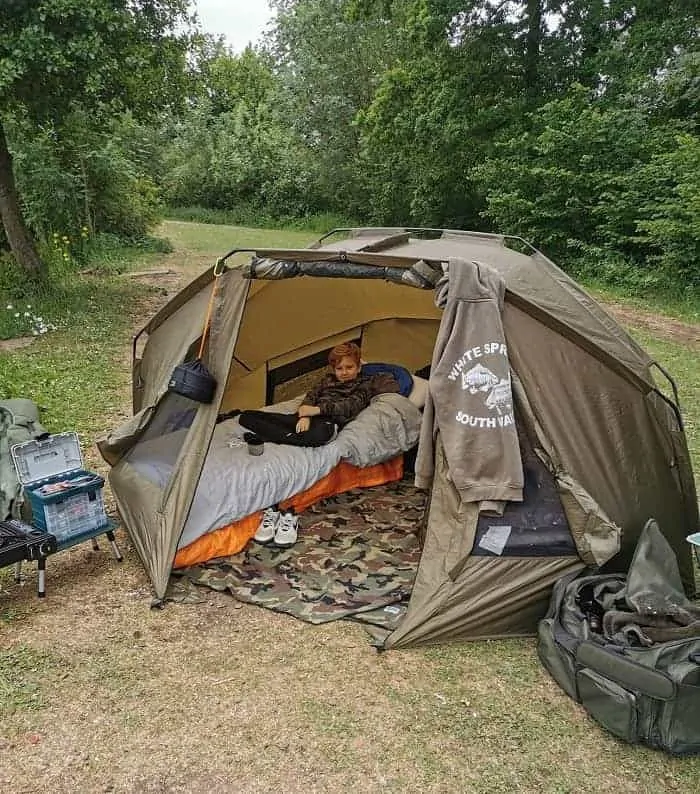
You most certainly can use a fishing bivvy for your camping trip! As this article has shown, a bivvy is, for the most part, a superior shelter choice when compared to a conventional camping tent.
It is optimal for longer fishing trips and can be highly recommended for when you are camping or hiking as well.
Especially when bringing the entire family on your camping trip, a bivvy will give you and your loved ones much more comfort than most tents.
And, as it offers much more space than common camping tents, it can actually be a lot of fun to spend longer periods of time inside of a bivvy, should the weather turn bad during your camping excursion.
It’s nice to have that little extra space and comfort when you can’t go outside especially for kids, and it can make your decision not to end your camping trip prematurely because of bad weather much easier.
I really hope that you have found this complete guide on fishing bivvies helpful and wish you wonderful nights on the bank!
Essential Tackle Tips
If you’re looking for solid and reliable carp fishing equipment, these tips might be useful for you.
The following tackle is of top quality and sells at a very decent price on Amazon.
I have been using this setup myself for many years and have caught plenty of big carp with it.
Rod: Daiwa Black Widow
A very strong and beautifully made 12ft 3lb carp rod with a ton of backbone and a great bend. Casts anything up to 5 oz extremely well and lets you navigate and control your fish smoothly and effectively. Fits both open and snaggy waters.
Reel: Shimano Baitrunner DL 6000
A reliable standard-sized baitrunner reel that works great for short to medium-distance carp fishing. Loads around 200 yards of 15-18lb monofilament mainline. Handles any wild run very smoothly! Fits the Black Widow rod perfectly.
Mainline: Daiwa Sensor 15lb
One of the strongest and most durable monofilament lines out there! Sells at a very good price and will last you for many fishing trips. Has just the right amount of stretch to perfectly hook and fight every fish.
Related Articles
- What Is an Unhooking Mat? (Carp Fishing Gear Explained)
- How to Fish Locked-Up the Right Way?
- Euro-Style Carp Fishing Gear (A Complete Guide)
Featured image courtesy of Ben Barber




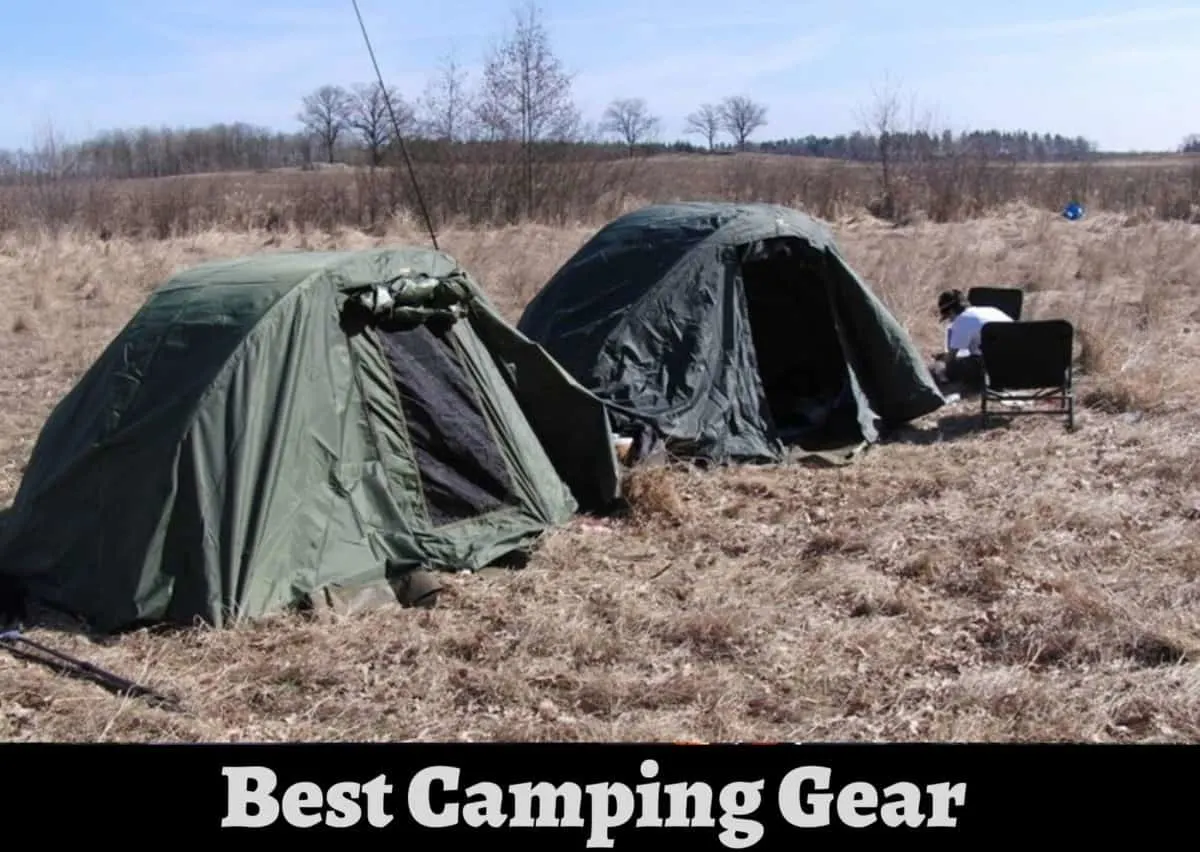
Would love to get this bivy av all ways wanted one can’t afored it a love to go trout fishing
Hi Steve! A bivvy is definitely a great piece of equipment to bring with you to the water. There are quite affordable models out there now as well, but I agree, generally, they aren’t cheap! You can always try FB and see if you find a good second-hand one. Those can often sell for very good prices!
Tight lines
/Max